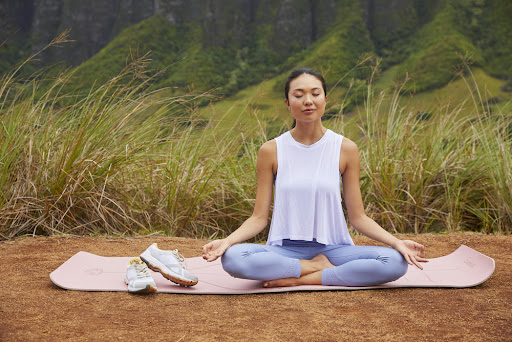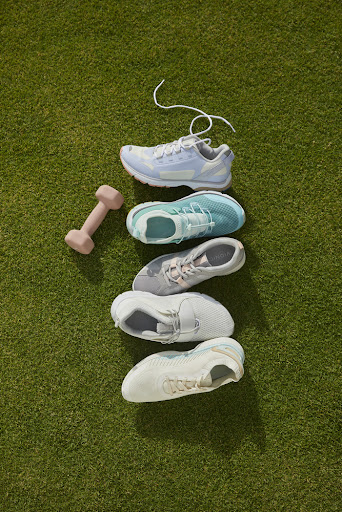It seems like everyone is talking about wellness nowadays. But what exactly do they mean? According to the Global Wellness Institute, “wellness” is about a state of “holistic health,” a well-rounded, optimal state of mental and physical health.1
It sounds ideal, but how does one get to such an all-around healthy state?
Cross training is one of the most powerful changes you can make to your workout routine to improve the health of your body across the board—and it’s backed by science. Plus, it’s easy to incorporate and it’s safe for a wide range of ages. Below, we’ll take a closer look at what cross training is, explore four meaningful benefits you can start tapping into today, and how to choose the best sneakers for working out safely.
What is Cross Training?
Cross training is merely the act of switching up your typical workout routine with a new kind of activity. For example, if you typically go for a run before work, you may skip a day of running to do some morning yoga or go for a swim at the gym instead. In either case, you’re cross training, because you’re taking part in a variety of exercises that work different muscles in the body.
Any new kind of exercise—whether it’s high- or low-impact— that you incorporate into your workout schedule counts. All that matters is that it helps you attain your personal fitness ambitions—even if that goal is simply to arrive at a downward facing dog with a bit more finesse.
Beyond developing a smoother yoga flow, let’s explore the other benefits you can expect to enjoy from cross training activity.
#1 Helps Achieve Total Body Fitness
Put simply, if you’re always doing the same kind of workout, you’re probably always targeting the same muscle groups. So, when you alternate between different kinds of exercises, you can strengthen those other muscles that have been hoping for some attention, too. Plus, you may even discover new muscle groups that you never even knew existed.
Studies have actually shown how small tweaks to an exercise routine can make a big difference when it comes to full-body and overall fitness. According to The Journal of Strength and Conditioning Research, a 2018 study showed that marathon runners who added cycling into their regimen significantly increased the strength of their hip flexors, muscles that aren’t normally fortified during running.2
#2 Can Prevent Injury
While focusing on the same muscle groups day after day will certainly strengthen and tone them, it may also wear them down. In fact, a 2017 study conducted by the University of Wisconsin showed that participants who focused on one kind of exercise had an 85% higher chance of injury.3
So, while there’s no trouble in picking a favorite sport or exercise, pouring all of your energy into one place could end up doing more harm than good.
For example, long-distance runners who seem to eat, sleep and breathe running may end up suffering from injuries like runner’s knee or stress fractures. In this case, simply squeezing in a few anaerobic workouts two or three times a week, could keep runners on the road longer—and with fewer aches and pains. The same goes for every individual’s workout routine and targeting different muscle groups to prevent injury.
#3 Could Improve Your Heart Health
Aside from helping to keep your body injury-free, cross training could be a boon to your heart health, too. That’s because distinct regions and muscles of the heart are at work during certain exercises. For example, yoga can relax the arteries, potentially leading to lower blood pressure,4 while swimming strengthens the left ventricle, making it easier for your heart to pump blood throughout the body.5
Incorporating a variety of exercises into your week can help strengthen each part of the heart, leading to improved heart health overall.
In the long term, boosting your cardiovascular endurance could lead to a longer, healthier lifespan. The BMJ, a medical journal associated with the British Medical Association, reports in a study that U.S. adults who alternated between cardio and anaerobic exercise on a weekly basis typically had a 40% lower risk of dying as a result of cardiovascular disease, cancer, diabetes, Alzheimer’s, or lower respiratory tract diseases.6
#4 Can Increase Motivation
Whether you’re a dedicated marathon runner, a lifelong yoga enthusiast, or a highly motivated weight lifter, performing the same exercises day in and day out can sometimes be a breeding ground for monotony. If the thought of cruising through your regular running route isn’t giving you the motivation you need to lace up your sneakers, perhaps it’s as simple as changing up the scenery from a road run to a trail run.
Other times, however, you might need to step away from the sport entirely—at least for a day.
Alternating new and old forms of exercise can help you come back to your standard routine with a fresh set of eyes—and a renewed sense of excitement. So, if you’ve lost that spark you used to have for the tennis court, or you simply can’t be bothered to step onto your yoga mat, consider giving yourself a break and trying something new. This ties back to how incorporating a cross training exercise routine can target different muscle groups and benefit your overall fitness.
Whenever you decide to give your training calendar a makeover, you might want to incorporate a mix of the following:
- Strength training activities
- Exercises that target flexibility and balance
- Cardio-focused workouts
Why is Cross Training Important?
Adding exercises to your regular physical activity can provide great benefits, from targeting different muscle groups to improving heart health and preventing injury. But why is cross training activity so important? One of the nicest perks about cross training is that it truly is for everyone—people of any age or fitness level can benefit from it. Whether you’re a serious athlete or an occasional gym goer, anyone who wants to move their body with intention has something to gain from trying something new.
According to the CDC, practicing strength training twice a week can help seniors improve balance, maintain strength, and reduce the risk of a dangerous fall.7 Even pediatricians are beginning to recommend their pint-sized patients practice a variety of activities to avoid injury or burnout.8
Clearly, cross training is becoming more than just a trend—it’s being recognized more and more as an essential part of maintaining physical wellness at any age.
How Can I Get Started?
Where you start on your fitness journey is completely up to you—or, if you’re recovering from an injury, it can be a joint decision made alongside a doctor or physical therapist.
But if you’re new to the practice of cross training, it could be a good idea to start small. In addition to your regular routine, you can consider:
- Pilates – Pilates strengthens the core, helping improve posture and decrease back pain. In many cases, it’s a slow-moving, gentle way of toning muscle.
- Yoga – Yoga is wonderful for flexibility, muscle conditioning, and joints, and it also offers a mind-body element that your typical workout may not. Yoga tends to focus just as much on mental and physical awareness as it does on building strength and fostering stability..
- Barre classes – Barre classes usually combine elements of yoga, Pilates, and ballet. Whether completed at home or in person, they can build strength and flexibility while toning muscles throughout the whole body.
- Walking – Even low-intensity activities like walking can help round out your workout schedule. Walking uses the same muscles as running, so it’s an active method of recovery on days when you can’t manage a full-on run.
- Surfing – For a complete change of scenery, try taking your workout from the gym or studio to the shore. Surfing is an effective full-body workout that can help you develop muscles in your core, upper body, and legs.
Sun Tzu, a Chinese philosopher, once observed that there are no more than five colors, “yet in combination, they produce more hues than can ever be seen.”9 The possibilities for your fitness routine are truly endless. But there’s no need to seek out a million new exercises—with cross training, you can experiment with new techniques or old favorites in the frequency and order that works for you in order to best reach your personal goals.
What Kind of Equipment Do I Need?
Many of the activities above—including yoga, Pilates, and barre—can be practiced in the comfort of your own home. Walking, surfing and even a friendly game of volleyball are all a quick drive to the beach away. Perhaps the only piece of equipment you need to begin unlocking the benefits of cross training is a pair of comfortable, well-fitted shoes that will protect your feet as you embark on your new regimen. You can learn about the difference between running shoes vs training shoes and find the perfect ones that fit your feet type.
Begin Your Cross Training Journey with Vionic Shoes
Cross training itself has almost become synonymous with the cross trainer, a kind of athletic training shoe. However, the best shoes for your workout regimen depend on what kind of workout you’re doing. Whether you’re looking for comfortable walking sandals, running shoes, or sneakers, Vionic is your best bet for finding the perfect pair.
For your beach workout, a pair of supportive walking sandals are essential. It can be difficult to find comfortable sandals for men, but luckily, Vionic has a number of options that are just as ideal for a lowkey yoga day at home.
Leave it to Vionic to give you the options you need to make your fitness journey fun, flexible, and comfortable—no matter where you end up!
Sources:
- “What is wellness?” Global Wellness Institute. https://globalwellnessinstitute.org/what-is-wellness/
- Leicht, Laurel. “5 Reasons You Seriously Want to Shake Up Your Fitness Routine On The Reg.” Women’s Health Mag. 6 August, 2019. https://www.womenshealthmag.com/fitness/g28568238/cross-training-benefits/
- “How Yoga Benefits the Heart.” Penn Medicine. 17 March, 2016.https://www.pennmedicine.org/updates/blogs/heart-and-vascular-blog/2016/march/how-yoga-benefits-the-heart
- Preiato, Daniel. “Cross-Training Is Effective for All Athletes.” Healthline. 3 December, 2019.https://www.healthline.com/health/fitness/cross-training#what-it-is
- Millard, Elizabeth. “Want to Live Longer? Prioritize Both Aerobic and Strength-Training Activities.” Runners World. 1 July, 2020.https://www.runnersworld.com/news/a33300768/cross-training-impact-on-longevity-study/
- Seguin, Rebecca et al. “Strength training for older adults.” CDC. 2002.https://www.cdc.gov/physicalactivity/downloads/growing_stronger.pdf
- “Cross Training for Children.” HSS.https://www.hss.edu/playbook/cross-training-for-children/
- Sun Tzu. “On the art of war”. Gutenberg project. https://www.gutenberg.org/files/132/132-h/132-h.htm
- Chertoff, Jane. “What’s the Difference Between Aerobic and Anaerobic?” Healthline.https://www.healthline.com/health/fitness-exercise/difference-between-aerobic-and-anaerobic
- Opler, Lorne David. “Your brain on barbells: Could strength training help improve your mood?” Washington Post. 2 September, 2020. https://www.washingtonpost.com/lifestyle/wellness/weightlifting-depression-anxiety-help/2020/09/01/d1036794-e882-11ea-bc79-834454439a44_story.html





Leave a Reply